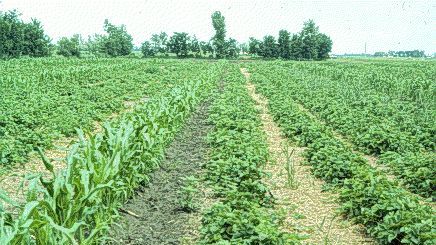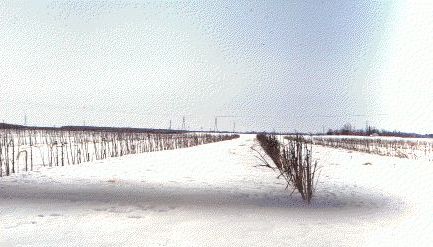Strawberry
Site Selection
- Soil Type
- Surface Drainage
- Soil Tilth
- Internal Drainage
- pH
- Salinity and Alkalinity
- Previous Crops
- Water quality for Irrigation
- Microclimate
- Permanent Shelterbelts
- Annual Supplementary Shelter
Site selection can have a significant bearing on the success of a U-Pick operation. Growers should consider factors such as soil, previous crops, water quality, micro climate, shelterbelts and markets.
The best soil for berry production is deep, well drained sandy loam, well supplied with humus (over 2% organic matter). Heavy clay soils that are usually poorly drained, encourage disease development and impede precisely timed field operations. Coarse textured sandy soils are often infertile and droughty, and require more frequent irrigation and greater attention to fertilization practices.Saline soils are not appropriate since strawberries have a low tolerance to salts. (The sensitive range is 1 mS/cm.) Plants established in low-lying muck or organic soils are more vulnerable to frost injury.
The surface drainage system must permit water to move from the field quickly and completely. Water standing on the strawberry field for a day or two will injure plants, especially when they are growing actively.
Soil tilth and nutrient availability can be improved by using green manure crops such as field peas, buckwheat, canola or rye. These crops can be rotated with the strawberry crop.
Poorly drained sites should be avoided. On sites with certain contours, such as dips, ridges and slopes, poor drainage can cause "yellowing" in strawberries. This condition can significantly reduce yields.
On sites where drainage is a problem, the use of clay or plastic drainage tile could be considered. Your Provincial Water Services Branch provides an advisory service for problems of this kind.
Strawberries prefer slightly acidic soils with pH 5.5 to 6.5. However, good vigor has been obtained on soils with a pH slightly higher than neutral (7.5). Soil pH levels over 8 can adversely affect certain strawberry nutrients, especially the iron levels in certain cultivars. Yellowing in strawberries is also common where soil pH is high.
The use of green manures and acidifying fertilizers can alter the soil pH to some degree.
The salt content (salinity) of some prairie soils is too high for successful commercial strawberry production. Strawberry plants have a low tolerance to salts and are sensitive at 1 mS/cm. For each unit increase in salinity above this threshold, yields decrease by 33%.
Irrigation water with significant salt content, combined with poor soils structure, may also cause soil to develop unacceptable salinity levels.
High alkaline soils can occur in bands or patches throughout a field. In strawberry production, this can cause yellowing or chlorosis of the plants, a condition that can lead to significant yield losses or complete plant die-back.
Strawberries should not be planted in soils where strawberries, raspberries, alfalfa, potatoes, peppers or eggplants have been grown in any of the previous four years unless the soil have been fumigated.The fungus diseases, black root rot and verticillium wilt will attack the above crops and build up in the soil. These diseases reduce the productivity of strawberry plants. Consider fumigation if a long-term rotation that excludes the host crops is not feasible.
Sites surrounded by natural bush stands may contain native strawberry plants. These plants can harbour insects, diseases and viral pathogens that may infect cultivated strawberry stands. To maintain good sanitation, it may be necessary to kill native strawberry stands within 1300 ft (400 m) of commercial strawberry fields.
Irrigation is essential for both consistent, high yielding strawberry production and frost control.
Since the Prairies have fairly low rainfall, and strawberry plants are shallow rooted, supplementary moisture is necessary to maximize production. An average of 12 in. (30 cm) of irrigation water is required over the growing season. Water applications may also be needed for spring frost control and summer crop cooling when temperatures are above average.
River or pond water is often used for irrigation. Well water may be suitable but should be tested to determine if the quality and quantity is satisfactory.
In Manitoba, the suitability of a water source may be tested by submitting a sample to your local GO office to send away for testing. Water quality should be satisfactory for strawberries if salinity is less than 1000 mS/cm, adjusted sodium absorption ratio (SAR) is less than 30 and chlorides are less than 3 meq/L-1. See local GO office for more details.
In the Prairies, a water rights licence is required before water can be taken from any source other than a pond filled completely by rain or snow that has fallen on the grower?s property. Construction of ponds or dams may also require approval. Water rights licences are issued by Manitoba Water Stewardship.
There are a number of assistance programs for the development of irrigation systems. For further details, contact the MAFRI Crops Knowledge Centre.
A microclimate is an area with uniform temperature, rainfall and drainage, and good protection from wind. These conditions are essential for successful strawberry production. If the site lacks a microclimate, the grower must create one.
Land that is slightly sloped provides good air and ideal water drainage. Wooded areas should be avoided because frost pockets can develop.
Strawberry plants also need adequate snowfall for winter insulation. Locations subject to lower early spring temperatures or limited snowfall are less than ideal for strawberry production.
If wind protection is lacking, shelterbelts should be planted to reduce wind velocity. Winds can dry fruit and plants during the growing season, desiccate plants during the dormant winter period, remove the winter snow cover and cause soil drifting during the plant establishment year. A properly planted and maintained shelterbelt can assist in obtaining a uniform blanket of snow to insulate plants from winter temperatures.
A number of ornamental plants are suitable for shelterbelts, and each has advantages and disadvantages. Two species that have performed well in Manitoba are Green Ash and Swedish Aspen. For specific shelterbelt recommendations, growers should consult with their local department of agriculture or Prairie Farm Rehabilitation Administration.
Ideally, the hedge should grow quickly, take up minimal amounts of land and produce a minimal amount of shade. Competition for fertilizer and moisture is also an important consideration. When selecting shelterbelt plants, avoid these characteristics:
- over-density of branches inhibiting snow infiltration
- wide spreading top
- high labour requirements for pruning
- limbs and branches susceptible to breakage from snow, ice and wind
- suckering roots
- high seedling production.

Plant shelterbelts 400 to 600 ft (122 to 183 m) Apart and in a direction that breaks the force of prevailing winds. Do not align shelterbelts so that natural air flow patterns are blocked. This is especially important on slopes, where stagnant air pockets can be created, leading to increased risk of frost.
Weed control, especially of broadleaf types, is a must in shelterbelts. Poorly maintained shelterbelts permit weed and leaf litter accumulations that foster a build up of slug and insect populations.

On the Prairies, supplementary shelter should be planted every 60 ft (18 m) Or so to enhance the effectiveness of the permanent shelter layout. Corn and sunflower plantings have been used successfully. When establishing a sunflower hedge, seed at a rate of 3 plants/ft (9 plants/m) to allow good wind and snow filtration.
Plant as early as possible in the spring. Ensure good fertility so maximum stalk development can take place.
